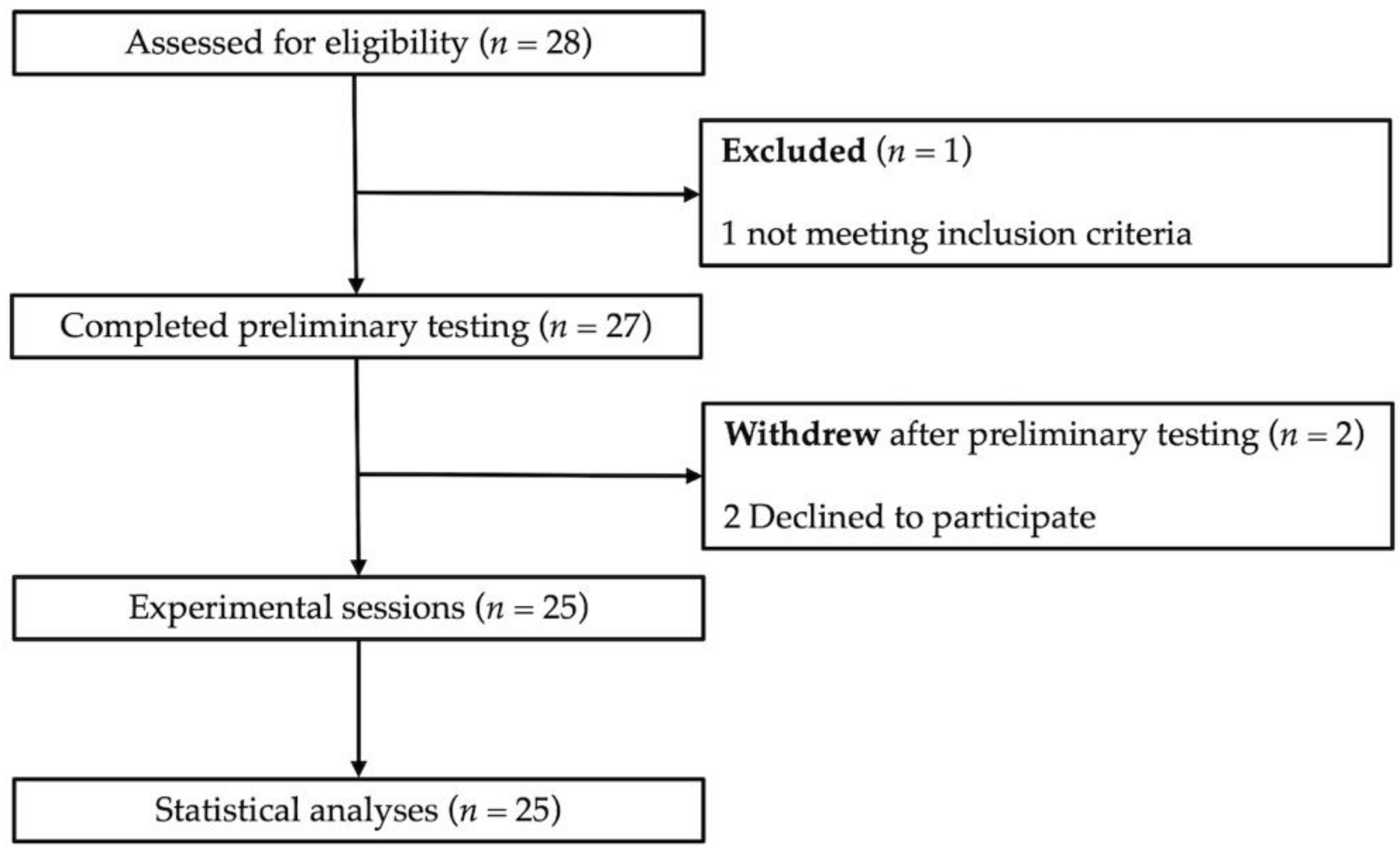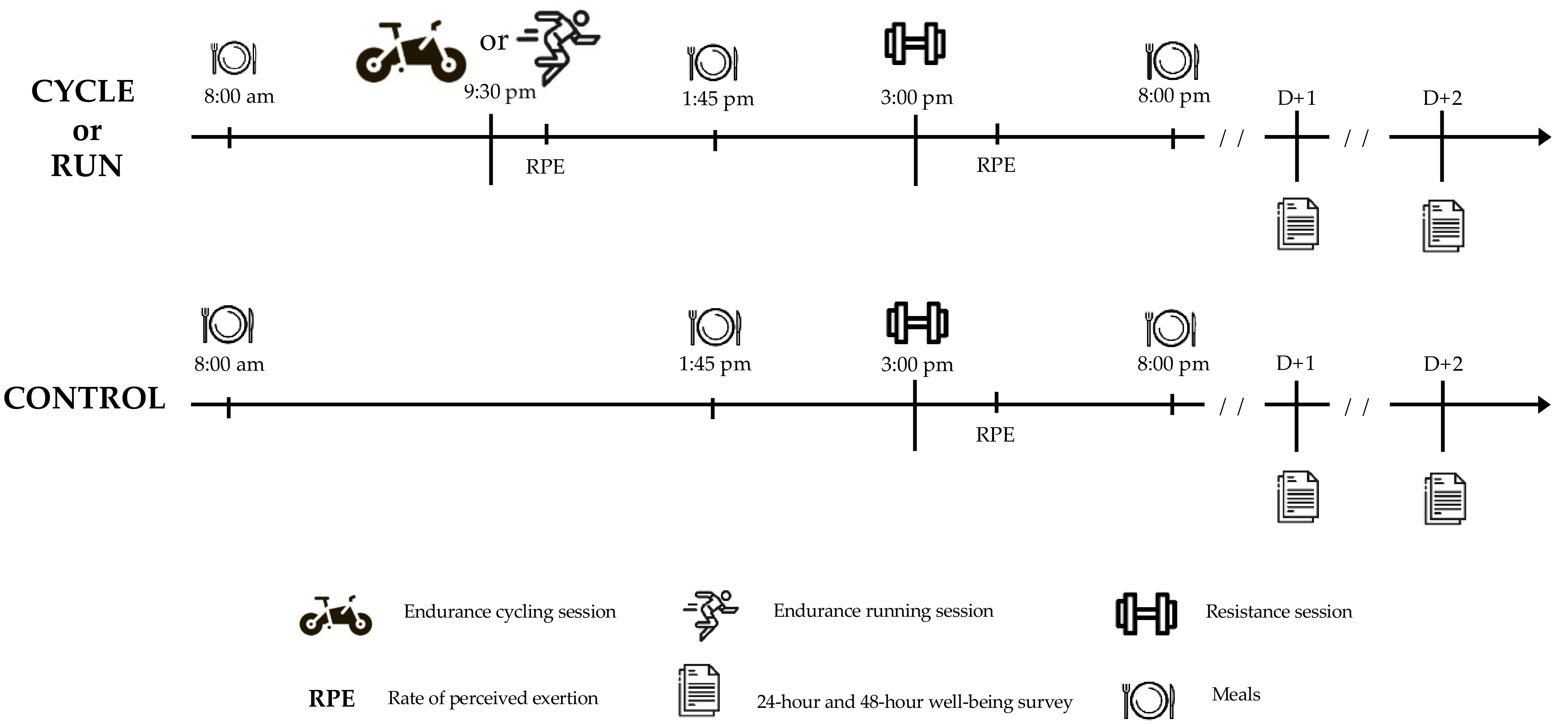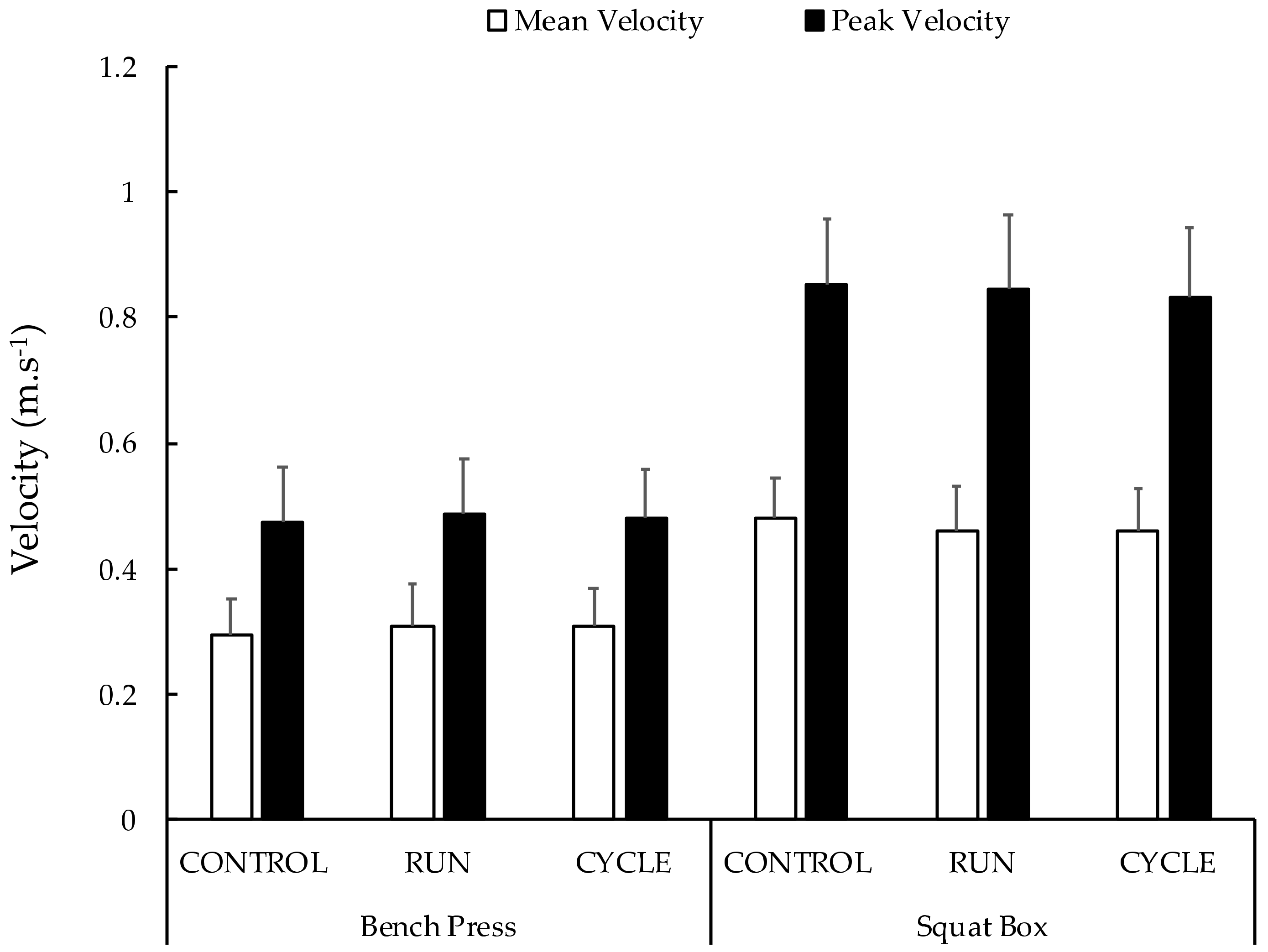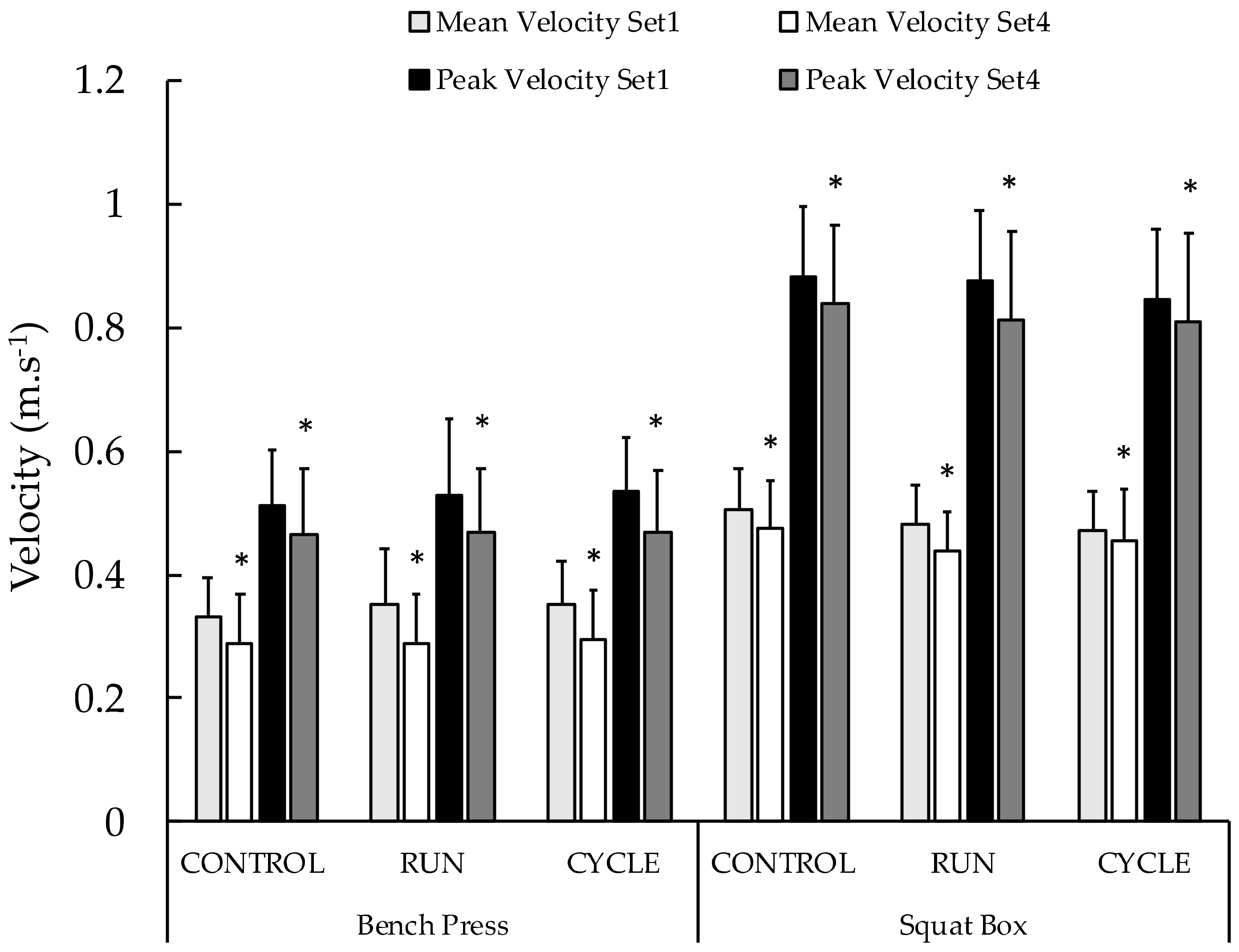Concurrent Training Programming: The Acute Effects of Sprint Interval Exercise on the Subsequent Strength Training
Abstract
:1. Introduction
2. Materials and Methods
2.1. Participants
2.2. Experimental Design
2.3. Training Procedures
2.4. Subjective Outcomes
2.5. Statistical Analyses
3. Results
4. Discussion
5. Limitations
6. Conclusions
Author Contributions
Funding
Institutional Review Board Statement
Informed Consent Statement
Data Availability Statement
Acknowledgments
Conflicts of Interest
References
- Hickson, R.C. Physiology interference of strength development by simultaneously training for strength and endurance. Eur. J. Appl. Physiol. 1980, 45, 255–263. [Google Scholar] [CrossRef] [PubMed]
- Costill, D.L.; Coyle, E.F.; Fink, W.F.; Lesmes, G.R.; Witzmann, F.A. Adaptations in skeletal muscle following strength training. J. Appl. Physiol. 1979, 46, 96–99. [Google Scholar] [CrossRef] [PubMed]
- Panissa, V.; Greco, C.; Ribeiro, N.; Julio, U.F.; Tricoli, V.; Franchini, E. Concurrent training and the acute interference effect on strength. Strength Cond. J. 2021. [Google Scholar] [CrossRef]
- Holloszy, J.O.; Coyle, E.F. Adaptations of skeletal muscle to endurance exercise and their metabolic consequences. J. Appl. Physiol. 1984, 56, 831–838. [Google Scholar] [CrossRef] [PubMed]
- Dudley, G.A.; Djamil, R. Incompatibility of endurance- and strength-training modes of exercise. J. Appl. Physiol. 1985, 59, 1446–1451. [Google Scholar] [CrossRef]
- Ratamess, N.A.; Kang, J.; Porfido, T.M.; Ismaili, C.P.; Selamie, S.N.; Williams, B.D.; Kuper, J.D.; Faigenbaum, A.D. Acute Resistance Exercise Performance Is Negatively Impacted by Prior Aerobic Endurance Exercise. J. Strength Cond. Res. 2016, 26, 1817–1826. [Google Scholar] [CrossRef]
- Reed, J.P.; Schilling, B.K.; Murlasits, Z. Acute neuromuscular and metabolic responses to concurrent endurance and resistance exercise. J. Strength Cond. Res. 2013, 27, 793–801. [Google Scholar] [CrossRef]
- Tan, J.G.; Coburn, J.W.; Brown, L.E.; Judelson, D.A. Effects of a single bout of lower-body aerobic exercise on muscle activation and performance during subsequent lower- and upper-body resistance exercise workouts. J. Strength Cond. Res. 2014, 28, 1235–1240. [Google Scholar] [CrossRef]
- Sale, D.G.; Jacobs, I.; Macdougall, J.D.; Garner, S. Comparison of Two Regimens of Concurrent Strength and Endurance Training. Med. Sci. Sports Exerc. 1990, 22, 348–356. [Google Scholar] [CrossRef]
- Craig, B.W.; Lucas, J.; Pohlman, R.; Stelling, H. The effects of running, weightlifting and a combination of both on growth hormone release. J. Strength Cond. Res. 1991, 5, 198–203. [Google Scholar] [CrossRef]
- Chtara, M.; Chaouachi, A.; Levin, G.T.; Chaouachi, M.; Chamari, K.; Amri, M.; Laursen, P.B. Effect of concurrent endurance and circuit resistance training sequence on muscular strength and power development. J. Strength Cond. Res. 2008, 22, 1037–1045. [Google Scholar] [CrossRef] [PubMed] [Green Version]
- Fyfe, J.J.; Bishop, D.J.; Stepto, N.K. Interference between concurrent resistance and endurance exercise: Molecular bases and the role of individual training variables. Sports Med. 2014, 44, 743–762. [Google Scholar] [CrossRef] [PubMed]
- Eddens, L.; van Someren, K.; Howatson, G. The Role of Intra-Session Exercise Sequence in the Interference Effect: A Systematic Review with Meta-Analysis. Sports Med. 2018, 48, 177–188. [Google Scholar] [CrossRef] [PubMed] [Green Version]
- Robineau, J.; Babault, N.; Piscione, J.; Lacome, M.; Bigard, X. Specific Training Effects of Concurrent Aerobic and Strength Exercises Depend on Recovery Duration. J. Strength Cond. Res. 2016, 30, 672–683. [Google Scholar] [CrossRef] [PubMed]
- Ballantyne, J. The Effect of Exercise Order on Same Day Concurrent Training: Implications for the Development of Maximal Strength, Power, Force and Changes in Body Composition in Recreationally Trained Men Following 5 Weeks of a Concurrent versus Resistance-Only Training Program; College of Sport and Exercise Science, Victoria University: Melbourne, Australia, 2017. [Google Scholar] [CrossRef]
- Cantrell, G.S.; Schilling, B.K.; Paquette, M.R.; Murlasits, Z. Maximal Strength, Power, and Aerobic Endurance Adaptations to Concurrent Strength and Sprint Interval Training. Eur. J. Appl. Physiol. 2014, 114, 763–771. [Google Scholar] [CrossRef]
- Wilson, J.M.; Marin, P.J.; Rhea, M.R.; Wilson, S.M.C.; Loenneke, J.P.; Anderson, J.C. Concurrent training: A meta-analysis examining interference of aerobic and resistance exercises. J. Strength Cond. Res. 2012, 26, 2293–2307. [Google Scholar] [CrossRef]
- Abernethy, P.J.; Quigley, B.M. Concurrent strength and endurance training of the elbow extensors. J. Strength Cond. Res. 1993, 7, 234–240. [Google Scholar] [CrossRef]
- Bentley, D.J.; Smith, P.A.; Davie, A.J.; Zhou, S. Muscle activation of the knee extensors following high intensity endurance exercise in cyclists. Eur. J. Appl. Physiol. 2000, 81, 297–302. [Google Scholar] [CrossRef]
- Sporer, B.C.; Wenger, H.A. Effects of aerobic exercise on strength performance following various periods of recovery. J. Strength Cond. Res. 2003, 17, 638–644. [Google Scholar] [CrossRef]
- De Souza, E.; Franchini, E.; Paulo, A.C.; Regazzini, M.; Ugrinowitsch, C. Acute effect of two aerobic exercise modes on maximum strength and strength endurance. J. Strength Cond. Res. 2007, 21, 1286–1290. [Google Scholar] [CrossRef] [Green Version]
- Robineau, J.; Lacome, M.; Piscione, J.; Bigard, X.; Babault, N. Concurrent training in rugby sevens: Effects of high-intensity interval exercises. Int. J. Sports Physiol. Perform. 2017, 12, 336–344. [Google Scholar] [CrossRef] [PubMed]
- Millet, G.Y.; Lepers, R. Alterations of neuromuscular function after prolonged running, cycling and skiing exercises. Sports Med. 2004, 34, 105–116. [Google Scholar] [CrossRef] [PubMed]
- Lepers, R.; Hausswirth, C.; Maffiuletti, N.; Brisswalter, J.; Van Hoecke, J. Evidence of neuromuscular fatigue after prolonged cycling exercise. Med. Sci. Sports Exerc. 2000, 32, 1880–1886. [Google Scholar] [CrossRef] [PubMed]
- Bijker, K.; de Groot, G.; Hollander, A. Differences in leg muscle activity during running and cycling in humans. Eur. J. Appl. Physiol. 2002, 87, 556–561. [Google Scholar] [CrossRef] [PubMed]
- Pageaux, B.; Lepers, R. Fatigue induced by physical and mental exertion increases perception of effort and impairs subsequent endurance performance. Front. Physiol. 2016, 29, 7–587. [Google Scholar] [CrossRef] [PubMed]
- Mcguigan, M.R.; Cormack, S.J.; Gill, N.D. Strength and power profiling of athletes: Selecting tests and how to use the information for program design. Strength Cond. J. 2013, 35, 7–14. [Google Scholar] [CrossRef] [Green Version]
- Rampinini, E.; Connolly, D.R.; Ferioli, D.; La Torre, A.; Alberti, G.; Bosio, A. Peripheral neuromuscular fatigue induced by repeated-sprint exercise: Cycling vs. running. J. Sports Med. Phys. Fitness 2014, 56, 49–59. [Google Scholar]
- McLean, B.; Coutts, A.; Kelly, V.; McGuigan, M.; Cormack, S. Neuromuscular, endocrine, and perceptual fatigue responses during different length between-match microcycles in professional rugby league players. Int. J. Sports Physiol. Perform. 2010, 5, 367–383. [Google Scholar] [CrossRef] [Green Version]
- Twist, C.; Waldron, M.; Highton, J.; Burt, D.; Daniels, M. Neuromuscular, biochemical and perceptual post-match fatigue in professional rugby league forwards and backs. J. Sports Sci. 2012, 30, 359–367. [Google Scholar] [CrossRef]
- Cohen, J.; Hillsdale, L. Statistical Power Analysis for the Behavioural Sciences, 2nd ed.; Lawrence Erlbaum Associates: New York, NY, USA, 1988. [Google Scholar] [CrossRef]
- Murach, K.A.; Bagley, J.R. Skeletal muscle hypertrophy with concurrent exercise training: Contrary evidence for an interference effect. Sports Med. 2016, 46, 1029–1039. [Google Scholar] [CrossRef]
- Cross, R.; Lovell, R.; Marshall, P.W.; Siegler, J. Acute neuromuscular response to team sports–specific running, resistance, and concurrent training. Med. Sci. Sports Exerc. 2022, 54, 456–465. [Google Scholar] [CrossRef] [PubMed]
- Bishop, D.J. Fatigue during intermittent-sprint exercise. Clin. Exp. Pharmacol. Physiol. 2012, 39, 9–15. [Google Scholar] [CrossRef] [PubMed] [Green Version]
- Bundle, M.W.; Weyand, P.G. Sprint exercise performance: Does metabolic power matter? Exerc. Sport Sci. Rev. 2012, 40, 174–182. [Google Scholar] [CrossRef] [PubMed]
- Petré, H.; Hemmingsson, E.; Rosdahl, H.; Psilander, N. Development of maximal dynamic strength during concurrent resistance and endurance training in untrained, moderately trained, and trained individuals: A systematic review and meta-analysis. Sports Med. 2021, 51, 991–1010. [Google Scholar] [CrossRef] [PubMed]
- Murlasits, Z.; Kneffel, Z.; Thalib, L. The physiological effects of concurrent strength and endurance training sequence: A systematic review and meta-analysis. J. Sports Sci. 2018, 36, 1212–1219. [Google Scholar] [CrossRef]
- Grabiner, M.; Owings, T. EMG Differences between concentric and eccentric maximum voluntary contractions are evident prior to movement onset. Exp. Brain Res. 2002, 145, 505–511. [Google Scholar] [CrossRef]
- Babault, N.; Pousson, M.; Ballay, Y.; Van Hoecke, J. Activation of human quadriceps femoris during isometric, concentric, and eccentric contractions. J. Appl. Physiol. 2001, 91, 2628–2634. [Google Scholar] [CrossRef]
- Newham, D.J.; McPhail, G.; Mills, K.R.; Edwards, R.H.T. Ultrastructural changes after concentric and eccentric contractions of human muscle. J. Neurol. Sci. 1983, 61, 109–122. [Google Scholar] [CrossRef]
- Gergley, J.C. Comparison of two lower-body modes of endurance training on lower-body strength development while concurrently training. J. Strength Cond. Res. 2009, 23, 979–987. [Google Scholar] [CrossRef]
- Panissa, V.L.G.; Tricoli, V.A.A.; Julio, U.F.; Ribeiro, N.; De Azevedo Neto, R.M.A.; Carmo, E.C.; Franchini, E. Acute effect of high-intensity aerobic exercise performed on treadmill and cycle ergometer on strength performance. J. Strength Cond. Res. 2015, 29, 1077–1082. [Google Scholar] [CrossRef]
- Tsitkanou, S.; Spengos, K.; Stasinaki, A.N.; Zaras, N.; Bogdanis, G.; Papadimas, G.; Terzis, G. Effects of high-intensity interval cycling performed after resistance training on muscle strength and hypertrophy. Scand. J. Med. Sci. Sport. 2017, 27, 1317–1327. [Google Scholar] [CrossRef] [PubMed]
- Clarkson, P.M.; Tremblay, I. Exercise-Induced muscle damage, repair, and adaptation in humans. J. Appl. Physiol. 1988, 65, 16. [Google Scholar] [CrossRef] [PubMed]
- Clarkson, P.M. Eccentric exercise and muscle damage. Int. J. Sports Med. 1997, 18, S314–S317. [Google Scholar] [CrossRef] [PubMed]
- Skorski, S.; Mujika, I.; Bosquet, L.; Meeusen, R.; Coutts, A.; Meyer, T. The temporal relationship between exercise, recovery processes and changes in performance. Int. J. Sports Physiol. Perform. 2019, 14, 156–162. [Google Scholar] [CrossRef] [PubMed]




| Session/Exercise | Variable | Condition Factor | Time Factor | Condition × Time | |||
|---|---|---|---|---|---|---|---|
| p-Value | d/pη2 | p-Value | pη2 | p-Value | pη2 | ||
| Endurance session | RPE at the end of the session | 0.519 | −0.131 | - | - | - | - |
| % change peak power vs. peak velocity | <0.001 * | 0.789 | - | - | - | - | |
| Box squat velocity | MV during the whole session | 0.308 | 0.048 | - | - | - | - |
| MV during the first and last series | 0.088 | 0.096 | 0.012 * | 0.234 | 0.336 | 0.044 | |
| % change of the MV | 0.334 | 0.045 | - | - | - | - | |
| PV during the whole session | 0.494 | 0.029 | - | - | - | - | |
| PV during the first and last series | 0.274 | 0.052 | 0.012 * | 0.236 | 0.626 | 0.019 | |
| % change of the PV | 0.615 | 0.020 | - | - | - | - | |
| Bench press velocity | MV during the whole session | 0.436 | 0.034 | - | - | - | - |
| MV during the first and last series | 0.716 | 0.014 | 0.001 * | 0.368 | 0.758 | 0.012 | |
| % change of the MV | 0.877 | 0.05 | - | - | - | - | |
| PV during the whole session | 0.658 | 0.017 | - | - | - | - | |
| PV during the first and last series | 0.598 | 0.021 | <0.001 * | 0.457 | 0.720 | 0.014 | |
| % change of the PV | 0.971 | 0.001 | - | - | - | - | |
| Resistance exercise session | Vertical jump height before the session | 0.089 | 0.096 | - | - | - | - |
| RPE at the end of the session | 0.038 * | 0.127 | - | - | - | - | |
| Variable | Condition Factor | Time Factor | Condition × Time | |||
|---|---|---|---|---|---|---|
| p-Value | pη2 | p-Value | pη2 | p-Value | pη2 | |
| Overall score | <0.001 * | 0.373 | 0.100 | 0.109 | 0.984 | 0.000 |
| Sleep | 0.369 | 0.041 | 0.913 | 0.000 | 0.957 | 0.002 |
| Nervousness | 0.445 | 0.033 | 0.252 | 0.054 | 0.978 | 0.000 |
| Fatigue | 0.019 * | 0.153 | <0.001 * | 0.450 | 0.741 | 0.012 |
| Muscle soreness | 0.006 * | 0.190 | 0.001 * | 0.503 | 0.892 | 0.005 |
| Palpation soreness | 0.008 * | 0.180 | 0.015 * | 0.222 | 0.704 | 0.015 |
| Downstairs soreness | 0.003 * | 0.218 | 0.002 * | 0.323 | 0.213 | 0.062 |
| Days | Conditions | Sleep | Nervous | Fatigue € | Muscle Soreness € | Palpations Soreness € | DownStairs Soreness € | Overall Score |
|---|---|---|---|---|---|---|---|---|
| D + 1 | CYCLE | 3.9 ± 0.8 | 3.5 ± 0.8 | 2.7 ± 1.0 | 2.7 ± 1.0 | 3.5 ± 0.8 | 3.7 ± 0.8 | 20.1 ± 3.9 |
| RUN | 3.9 ± 1.0 | 3.6 ± 0.9 | 2.5 ± 0.9 $ | 2.1 ± 1.1 * | 2.9 ± 0.8 * | 3.0 ± 0.9 * | 17.9 ± 4.1 * | |
| CONTROL | 4.1 ± 0.8 | 3.7 ± 0.8 | 3.1 ± 0.9 | 2.9 ± 1.1 | 3.5 ± 0.8 | 3.7± 0.8 | 21.1 ± 3.6 | |
| D + 2 | CYCLE | 4.0 ± 0.6 | 3.6 ± 1.0 | 3.2 ± 1.0 | 3.2 ± 1.1 | 3.7 ± 0.9 | 3.9 ± 0.8 | 21.7 ± 4.0 |
| RUN | 3.9 ± 1.1 | 3.4 ± 0.9 | 2.9 ± 1.0 $ | 2.5 ± 1.1 * | 3.3 ± 0.8 * | 3.5 ± 1.3 * | 19.4 ± 4.0 * | |
| CONTROL | 4.1 ± 0.8 | 3.7 ± 0.8 | 3.4 ± 1.0 | 3.3 ± 1.2 | 3.7 ± 1.0 | 4.2 ± 0.8 | 22.5 ± 4.6 |
Publisher’s Note: MDPI stays neutral with regard to jurisdictional claims in published maps and institutional affiliations. |
© 2022 by the authors. Licensee MDPI, Basel, Switzerland. This article is an open access article distributed under the terms and conditions of the Creative Commons Attribution (CC BY) license (https://creativecommons.org/licenses/by/4.0/).
Share and Cite
Mathieu, B.; Robineau, J.; Piscione, J.; Babault, N. Concurrent Training Programming: The Acute Effects of Sprint Interval Exercise on the Subsequent Strength Training. Sports 2022, 10, 75. https://doi.org/10.3390/sports10050075
Mathieu B, Robineau J, Piscione J, Babault N. Concurrent Training Programming: The Acute Effects of Sprint Interval Exercise on the Subsequent Strength Training. Sports. 2022; 10(5):75. https://doi.org/10.3390/sports10050075
Chicago/Turabian StyleMathieu, Bertrand, Julien Robineau, Julien Piscione, and Nicolas Babault. 2022. "Concurrent Training Programming: The Acute Effects of Sprint Interval Exercise on the Subsequent Strength Training" Sports 10, no. 5: 75. https://doi.org/10.3390/sports10050075
APA StyleMathieu, B., Robineau, J., Piscione, J., & Babault, N. (2022). Concurrent Training Programming: The Acute Effects of Sprint Interval Exercise on the Subsequent Strength Training. Sports, 10(5), 75. https://doi.org/10.3390/sports10050075







